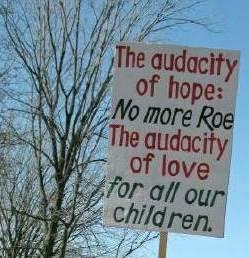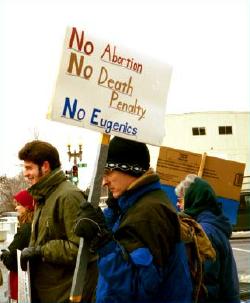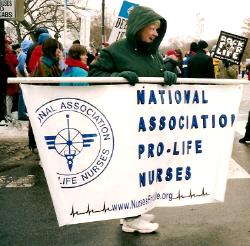 This essay commented on an April 20, 2009 Washington Post column by Ruth Marcus, who wrote about Gov. Sarah Palin and her youngest child, Trig, who has Down syndrome. Marcus argued that whether to abort a child for Down syndrome or other reasons "is a personal issue and a personal choice" and that the "government has no business taking that difficult decision away from those who must live with the consequences." This response to Marcus was posted on May 1, 2009. Abortion, Choice, and Eugenics Mary Meehan In her April 20th Washington Post column about "Palin's Personal Choice," Ruth Marcus missed an ironic point. By taking the lives of human beings, abortion ends all of their choices, liberties, and rights along with their very existence. Marcus should compare abortion with domestic violence. There was a time when many women couldn't escape regular violence from their husbands, partly because police did not enforce laws against assault. Frustrated by the failure of abused wives to press charges against their husbands, and not understanding the deep terror that led to that failure, police often used a laissez-faire approach, which might also be called "pro-choice." The husband could choose to beat his wife, but the wife (so they thought) could choose to leave her husband. In fact, many women were so terrorized by threats of retaliation, and so depressed, that they didn't have free choice in these cases. But the deeper fact is that husbands have no right to beat their wives in the first place. While domestic violence is still a major problem, many police departments now handle it better than they did in the past. Rejection of the laissez-faire, pro-choice approach was the key turning point. It is also the turning point on other issues of violence. Liberals who take an anti-choice position on domestic violence, war, the death penalty, and torture--yet take a pro-choice position on abortion--are deeply inconsistent. Marcus indicates doubt about "when life begins." Yet the science of human embryology tells us that a human life begins at fertilization. In the case of identical twinning, a second human being begins when the first embryo divides (a form of asexual reproduction).(1) But whether starting as a singleton or an identical twin, each of us started life as a tiny embryo. This is true of Ms. Marcus, President Obama, every justice of the Supreme Court, and everyone else in the world. And it's true whether we started the old-fashioned way or by laboratory fertilization. Marcus notes that "the abortion rate is as high as 90 percent" in the case of Down syndrome. This results largely from the work of a movement she might be hard put to defend: the eugenics movement that tries to breed a "better" human race. Frederick Osborn, the mastermind of the American Eugenics Society for much of the 20th century, declared in 1941: "The public should insist that doctors and public health authorities get to work at reducing the number of defectives." Later he wrote that people who were "not capable of sound thinking should be reduced in number as rapidly as possible." A eugenics colleague responded that this "sounds a little stark. It gives me an impression that the guillotine is just around the corner."(2)  While focused on sterilization and contraception in early years, Osborn and many colleagues later advocated prenatal testing and eugenic abortion. But Osborn, who said that eugenic goals "are most likely to be attained under a name other than eugenics,"(3) preferred the genetics label. All of the founding officers of the American Society of Human Genetics--and many later ones, including Osborn himself--were eugenicists.(4) They put a deep imprint on this key professional group, which has promoted prenatal testing for decades. The March of Dimes funded much early research on prenatal testing. This is not surprising when you realize that Dr. Virginia Apgar, a key March of Dimes leader at the time, was also a member of the American Eugenics Society.(5) Meanwhile, other members of the eugenics group--including Planned Parenthood president Alan Guttmacher, ethicist Joseph Fletcher, and environmentalist Garrett Hardin--worked to legalize abortion.(6) They saw it as a necessary means to their goal of a smaller but supposedly better human population. By 1979 Frederick Osborn, using the old and offensive term of "mongoloid" for someone with Down syndrome, wrote that prenatal testing meant that "the birth of another mongoloid child" could be prevented through abortion. He felt that "a sharp reduction in the birth of mongoloids would seem appropriate."(7) Osborn, who died two years later, would have approved today's high abortion rate for children with Down syndrome. Prenatal testing is a huge funnel that is very wide at the top--enticing and pressuring women and couples to agree to testing--and very narrowly pointed toward eugenic abortion at the bottom. Gov. Sarah Palin was caught in this funnel for a short time. But she knows that her son Trig, who has Down syndrome, has the same right to life that all of us have. That he had this right before birth, by virtue of his humanity. And that health care professionals who are not corrupted by eugenics do much to make life better for people with every kind of disability.  Notes 1. T. W. Sadler, Langman's Medical Embryology (Baltimore: Williams & Wilkins, 7th ed., 1995), 3; and Keith L. Moore and T. V. N. Persaud, Before We Are Born: Essentials of Embryology and Birth Defects (n.p.: Saunders/Elsevier Science, 6th ed., 2003), 2, 111, & 114. 2. Frederick Osborn, "Eugenics and National Defense," Eugenical News 26, no. 2 (June 1941), 37-39, 38; Frederick Osborn, "Heredity and Practical Eugenics Today," ibid., vol. 33, nos. 1-2 (March-June 1948), 1-6, 6; and Sheldon C. Reed, ibid., vol. 33, nos. 3-4 (Sept.-Dec. 1948), 46. 3. Frederick Osborn, The Future of Human Heredity: An Introduction to Eugenics in Modern Society (New York: Weybright and Talley, 1968), 104. 4. "List of Members of the American Eugenics Society" (New Haven, Conn., August 1930); "Membership List, 1956, American Eugenics Society, Inc.," Eugenics Quarterly 3, no. 4 (December 1956), 243-52; 1974 membership list of Society for the Study of Social Biology [the old American Eugenics Society renamed], American Eugenics Society Records, American Philosophical Society Library, Philadelphia, Pa.; Eugenics Quarterly, 1954-68; Social Biology [Eugenics Quarterly renamed], 1969-93. Information on members and directors in these sources was cross-checked with American Society of Human Genetics officers listed in American Journal of Human Genetics, vol 3 (1951)-vol. 48 (1991) and with "ASHG Presidents, 1949-2008," www.ashg.org/pages/about_history.shtml. 5. National Foundation March of Dimes, annual reports 1969-74; and Who's Who in America, 37th ed., 1972-73, vol. 1, 79 (Virginia Apgar). 6. The names of Guttmacher, Fletcher, and Hardin are on the 1956 membership of the American Eugenics Society (n. 4). Guttmacher was vice president of the eugenics group in 1956-63 and served on its board in 1955 and 1964-66; and Hardin was on its board in 1972-74. See Eugenics Quarterly, 1955-66 and Social Biology, 1972-74. 7. Frederick Osborn, Voyage to a New World: 1889-1979 (Garrison, N.Y.: privately printed, 1979), 125. |